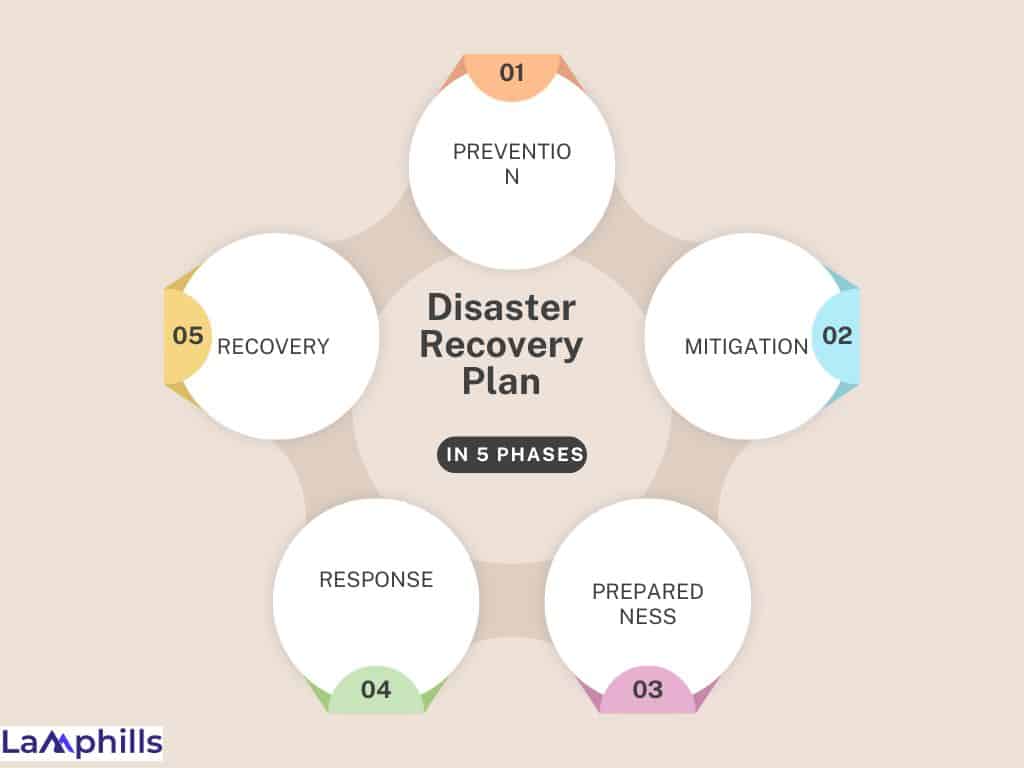What would happen if a disaster suddenly destroyed your business’s access to critical systems, data, or physical infrastructure? Do you recover fast, or would operations be slowed to a standstill pace? This is where the importance of Disaster Recovery and How to Prepare and Implement it in Your Organization comes into play. In today’s world of technological advancement, an organization has to have a strategy to handle sudden disruptions that may develop into massive losses. A Disaster Recovery plan deals with business continuity, whereby an organization can resume operations after a disaster.
In this piece, I will explain what disaster recovery is. Plus, how to create and implement a Disaster Recovery plan for your organization, including a basic template. We will also look at an example of a Disaster Recovery plan to highlight these procedures. Whether your organization is small or large, having a sound strategy may help you limit many risks and preserve your company’s future.
Key Points
- Disaster recovery involves restoring essential business processes, systems, and data after disruptions like natural disasters or cyber-attacks. A well-structured disaster recovery plan (DRP) is crucial to minimize downtime, financial losses, and reputational damage, ensuring quick recovery and continuity of operations.
- The process includes a risk assessment to identify threats and critical assets, conducting a business impact analysis (BIA) to understand potential consequences, and designing effective backup and recovery strategies to incorporate data backups, replication, and cloud-based solutions.
- Effective communication is vital during a disaster recovery process. Organizations should establish a communication plan to keep employees, customers, and stakeholders informed about the disaster status, service disruptions, and recovery timelines, including a contact information sheet for key personnel.
- A disaster recovery plan should not be static. It requires regular testing through simulated disaster scenarios to identify weaknesses and make necessary adjustments, ensuring the plan remains effective and up-to-date.
What is Disaster Recovery?
Disaster recovery is restoring business-critical processes, systems, and data following disruptions caused by natural disasters, cyber-attacks, hardware failures, or other events. Specifically focused on recovering technology infrastructure and services, it is a sub-discipline of business continuity planning.
Without a Disaster Recovery plan, an organization could face multiple long-run downtime scenarios, financial losses, reputational damages, or legal actions. The goal of DR is to lessen the impact of disasters, and time losses from incidents, and ensure the availability of critical applications and data as quickly as possible.
Importance of Disaster Recovery
The risks of a disaster without recovery for organizations could be critical: hardware might become damaged, vital data might be lost, and other normal operations could halt and translate into major financial setbacks. In worst cases, businesses experiencing prolonged downtime may never recover from it.
Consider a retail firm that lost its credit card processing for several hours. It would not only forfeit revenue immediately but could also tarnish the company’s reputation if customers lost faith in its ability to provide service.
On the other hand, a sound Disaster Recovery plan provides for a speedy return to normal conditions with the least disturbance. It shows a delineated route map for disaster response, recovery coordination, and key operations resumption.
Disaster Recovery Plan: How to Prepare for and Implement it.
There are phases involved in creating and carrying out a disaster recovery plan. This helps organizations, through such steps, to come up with an effective DR plan suitable for them.
#1. Risk Assessment – Identification of Critical Assets
First comes the risk assessment, which means assessing certain possible threats to your business. Risk varies from organization to organization as it depends on many factors related to its location, industry, and technological setup. While companies located in coastal areas are highly prone to flooding or hurricanes, technological firms remain at greater risk regarding cyber-attacks.
Once the risks have been identified, you should determine which systems, data, and business processes are most integral to your organization’s operations. These should be the assets upon which most of the attention in your DR plan should focus.
#2. Business Impact Analysis
Secondly, after the identification of critical assets is performed, a Business Impact Analysis should be conducted. It will provide insight into the possible effects different types of disasters have on your organization and enable you to establish RTOs and RPOs for each critical system.
The BIA addresses several key questions such as:
- How long can your business afford to be offline?
- Downtime: what does it cost, and what are the financial and operational consequences?
- How much data loss is tolerable for your organization?
#3. Backup and Recovery Design Strategies
Organizations should put in place elaborate designs for backup and recovery to ensure that their core systems and data are recovered fast in case a disaster strikes. This normally involves:
- Data Backups: This involves periodic data backup of applications and system configuration to an offsite location.
- Data Replication: Real-time or near-real-time data replication at a secondary site will be one of the most important for organizations with Low RPOs.
- Cloud-based Solutions: Availing cloud services for storage and data recovery provides flexibility and scalability. Cloud-based DR solutions automate backup operations and allow restoration to be realized in minimal time.
#4. Develop Communications Plan

The success of any Disaster Recovery plan starts and concludes with effective communication. Therefore, a company should create a communication strategy that includes its employees, customers, and stakeholders at every stage of recovery. It may involve:
- Notifying employees of the status of the disaster and recovery process.
- Inform clients of any disruption to service and provide information regarding when the services will resume.
- Liasoning with partners, suppliers, and vendors regarding expected delays or operational changes.
The communication plan has to highlight the contact information sheet that comprises all key personnel, and stakeholders, and looks at what installed channels through which communications shall go: e-mail, phone number, or messaging apps.
#5. Periodic Testing of the Plan
Developing the DR plan is, however, not a once-in-a-lifetime activity. Tests to confirm its efficiency need to be administered regularly by simulating the disaster scenarios. These tests find further weaknesses or gaps within the planned flow and make necessary improvements.
Organizations should verify during testing:
- Their backup and recovery procedures’ effectiveness.
- How often do the employees know about their roles and responsibilities?
- Communication efficiency during the actual disaster.
- In addition, the DR plan should be reviewed for changes in technology, when new risks appear, or with modifications in the organization’s infrastructure.
#6. Implement Continuous Monitoring and Improvement
Additionally, after developing the disaster recovery plan, systems, networks, and infrastructure must be monitored continuously. The possibilities of threats make it crucial to monitor continuously to enable organizations to take preventive action to avoid disaster. The continuous improvement will keep the DR plan effective and applicable to the organization’s needs.
#7. Recovery Objectives:
Any Disaster Recovery plan has two main objectives:
- Recovery Time Objective (RTO): The longest period of downtime that a system should be in without requiring restoration.
- RPO: This is the maximum amount of data loss an organization may suffer in a given period. For example, an RPO of four hours indicates that a business is prepared to lose four hours of data.
#8. Testing and Maintenance:
Periodic testing of the DR plan ensures that it comes into play as expected. Testing, in addition, locates areas of possible improvements within the system. The plan’s review is also necessary to update the organization’s systems, infrastructure, and business procedures.
Disaster Recovery Plan Template
Here is a simple template for developing a Disaster Recovery plan:
1. Introduction:
- This is a general description of the purpose and scope of the Disaster Recovery Plan.
2. Risk Assessment:
- List of potential threats: Natural disasters, cyber-attacks, hardware failure, etc.
- Assessment of the probability and impact of each threat.
3. Business Impact Analysis (BIA):
- Critical systems, data, and processes identification.
- In this sense, every critical asset has an associated Recovery Time Objective and a Recovery Point Objective, RTOs, and RPOs respectively.
4. Backup and Recovery of Data:
- Overview of backup procedures: frequency, location of back-ups, etc.
- Data recovery procedures and timelines.
5. Duties and Responsibilities:
- This includes members and responsibilities of the Disaster Recovery team.
6. Communication Plan:
- Communication planning: how will the employees, clients, and stakeholders get to know?
- Details of names and contact information for the key personnel.
7. Testing and Maintenance:
- Schedule regular testing of the DR plan.
- Procedures to update the plan as needed.
LAMPHILLS CURATED DISASTER RECOVERY TEMPLATE
DOWNLOAD HERE
Example of a Disaster Recovery Plan
To understand how to approach a disaster recovery plan, consider this general example of a small e-commerce company.
Company: ABC E-Commerce
#1. Introduction:
This Disaster Recovery Plan details the steps to recover from such a disaster that may affect its online store, payment, and customer information processing at ABC E-Commerce.
#2. Risk Analysis:
- Cyberattacks: High likelihood, high impact.
- Server Failure: Medium befalling probability, high impact.
- Natural Disasters (Flooding, Earthquake): Low probability; high impact.
#3. BIA: Business Impact Analysis
- The e-commerce website is critical, requiring RTO-4 hours and RPO-1 hours of availability.
- Payment Processing: Critical – RTO 1 hour; RPO 30 minutes.
- Customer Data: Critical: RTO 2 hours, RPO 30 minutes.
#4. Data Backup and Recovery:
Hourly backups of data are kept in an offshore cloud solution. Data replication in real-time to a backup server located in a different area. Failure: Critical system recovery will take one to four hours, depending on the priority.
#5. Roles and Responsibilities:
- Disaster Recovery Manager: Jane Doe.
- IT personnel: John Smith, Sarah Lee.
- Communications Officer: Michael Brown.
#6. Communication Plans
Disaster notifications will shortly be sent to employees via e-mail and SMS. Clients will be notified of any disturbance to operations through email and social media.
#7. Testing and Maintenance:
Simulated DR plan testing will be done quarterly. Then, this plan is reviewed and updated at the end of the year, or if infrastructure changes are substantial.
What Are the Five Phases of Disaster Recovery Plan?

The following are the five stages of the Disaster-Management Cycle;
- Prevention. The best course to take when it comes to a disaster is that of prevention.
- Mitigation. Relief focuses on reducing the number of people who will be affected or lose their lives by a disaster.
- Preparedness.
- Response.
- Recovery.
What Are the Three Types of Disaster Recovery Plans?
Types of Disaster Recovery
- Data Centre Disaster Recovery. This type of disaster recovery focuses on building safeguards for physical IT assets and having copies of such data.
- Cloud Disaster Recovery.
- Network Disaster Recovery.
- Virtualised Disaster Recovery.
- Disaster recovery as a service.
How Do You Write a Disaster Recovery Plan?
- Determine the plan’s objectives and scope.
- Conduct a risk assessment.
- Conduct a business impact analysis.
- Define the recovery measures and methods.
- Conduct regular testing and training.
- Review and revise the plan regularly
A detailed checklist of how brands can write a disaster recovery plan as curated by LampHills
What Are the 4 CS of Disaster Recovery?
The four C’s of Disaster Recovery: Communication, Coordination, Continuity, and Collaboration.
What Are the Three Main Items in Disaster Recovery?
There are three key things to consider when creating your disaster recovery plan.
They are: deciding on an effective backup strategy, knowing your business impact analysis (BIA), and knowing your recovery time objective (RTO) and recovery point objective (RPO).
Conclusion
A properly planned and implemented Disaster Recovery plan is a crucial requirement for any organization today, regardless of its size.
In this regard, by undertaking a process of risk assessment, defining the objectives of recovery, and laying down clear procedures for backup creation and communication, organizations will be able to reduce the impact of disasters to almost nil and ensure the continuation of business with full force within a very short time. Whether starting from scratch or refining a plan in place, these steps here will provide great ground for their Disaster Recovery strategy. With this in place, your organization will be ready for the unexpected and thereby safeguard its future.
Related Posts
- Reputation Recovery: How Experts Turn Negative PR into a Growth Opportunity
- The Worst PR Disasters of All Time: Lessons I Learned (+ Tips)
- How to Create an Effective Crisis Management Team: 6 Key Steps
- Types of Crises in Public Relations: How to Identify and Manage Them






